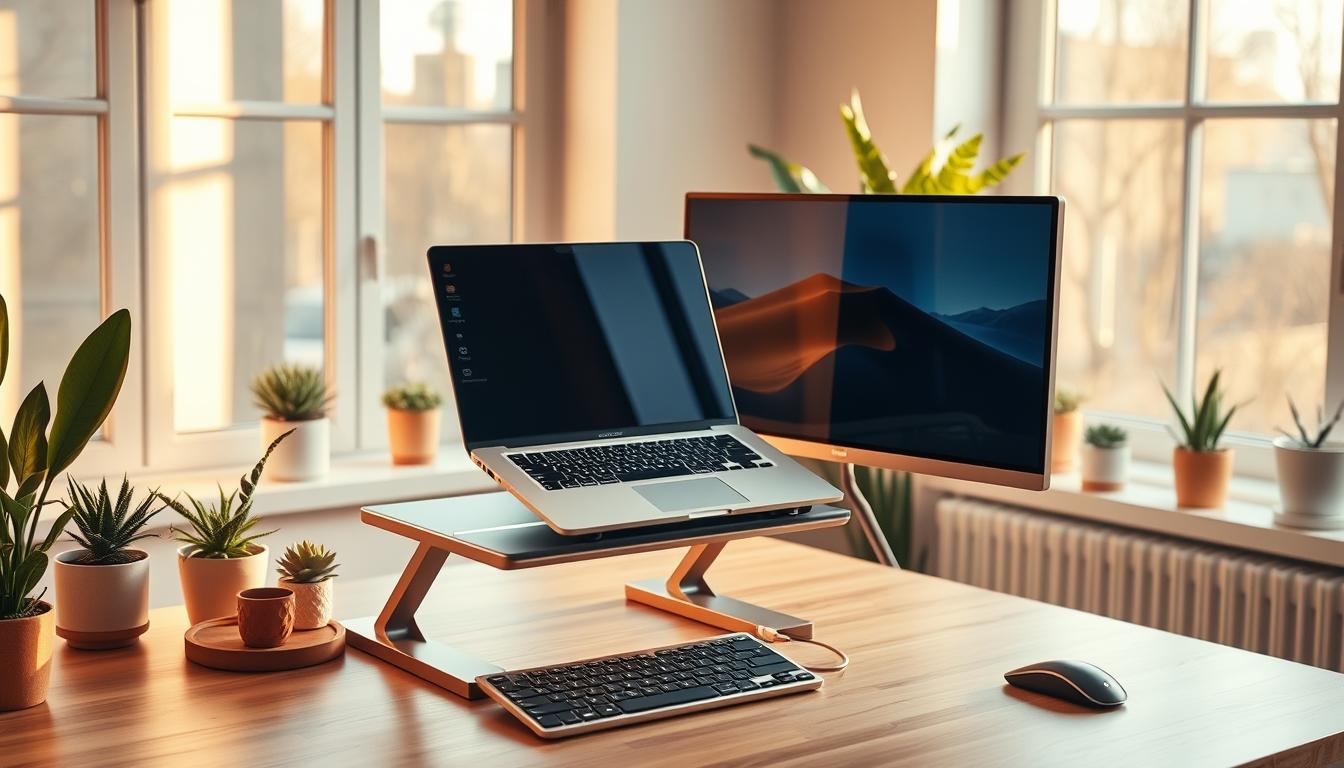Creating an Ergonomic Laptop Setup: Stands and Docking Stations
Working from your home office can affect your health and productivity. An ergonomic workspace is key to staying comfortable and efficient.
An ergonomic laptop setup means arranging your space to avoid body strain. It uses devices that help you keep good posture and reduce eye strain.
Getting the right tools, like laptop stands and docking stations, can greatly improve your work. These tools help you work in a more comfortable position. This boosts your well-being and productivity.
Importance of an Ergonomic Laptop Setup
An ergonomic laptop setup is key for good posture and health. It’s important to arrange your workspace right to avoid discomfort and long-term damage.
Understanding Ergonomics and Its Benefits
Ergonomics is about designing your workspace to reduce body strain. An ergonomic workspace lowers the risk of musculoskeletal disorders and eye strain. This boosts your productivity and well-being.
Good posture, less fatigue, and more comfort are benefits of an ergonomic setup. Using laptop stands and other accessories supports your health and work efficiency.
How Poor Posture Affects Your Health
Poor posture can cause back pain, neck strain, and headaches. Working on a laptop that’s not right can lead to long-term damage to your body.
It can also harm your breathing and digestion. A proper ergonomic setup keeps you healthy and comfortable at work.
Signs You Need to Improve Your Setup
Signs you need a better setup include back or neck pain, feeling tired, or less productive. If you often adjust your position or feel uncomfortable, it’s time to check your workspace.
- Frequent back or neck pain
- Eye strain or headaches
- Decreased productivity
- Discomfort during or after work
Recognizing these signs and making changes can make your workspace better. Adding ergonomic workspace essentials like laptop stands can greatly improve your work experience.
Key Elements of an Ergonomic Desk
To create a comfortable workspace, several factors are important. An ergonomic desk is not just about looks. It’s about making a comfortable laptop workstation that boosts productivity and keeps you healthy.
Appropriate Height for Your Workspace
The height of your desk is key for good posture. Your desk should let you work with elbows at 90 degrees and wrists straight. This prevents strain on your shoulders and wrists.
- Make sure your feet are flat on the floor or on a footrest.
- Keep your knees at or below hip level.
- Adjust your chair height for comfort.
Importance of Chair Support
A good chair is essential for your lower back’s natural curve. Look for a chair that adjusts in height and lumbar support. Good chair support reduces back pain and helps maintain posture.
Positioning Your Laptop Screen
Correctly placing your laptop screen is key for eye comfort and posture. The screen’s top should be at eye level or slightly below. It should be about 20-25 inches from your eyes.
- Adjust the screen brightness to a comfortable level.
- Use a laptop stand for the best viewing height.
- Place the screen directly in front of you to avoid neck strain.
Types of Laptop Stands
Choosing the right laptop stand can seem hard with so many options. But knowing the different types makes it easier. Laptop stands vary to meet different needs.
Adjustable versus Fixed Stands
Adjustable laptop stands let you change height and angle. This is key for a good ergonomic setup. It helps you keep your laptop at the right height for good posture.
Fixed stands are simpler and often cheaper. They set your laptop at a fixed height. They’re not as flexible but can be more durable because they have fewer parts.
Aesthetic Options for Every Style
Laptop stands are not just useful; they also match your style. You can find stands that are sleek and modern or simple and minimalist. There’s a stand for every taste.
- Modern designs with sleek lines and metallic finishes
- Minimalist stands that blend into your workspace
- Colorful options to add a pop of color to your desk
Budget-Friendly Choices
You don’t have to spend a lot on a laptop stand. There are many budget-friendly options that work well. Look for stands made from affordable materials that support your laptop well.
When looking for cheap stands, consider these:
- Material durability
- Weight capacity
- Adjustability (if that’s a feature you need)
Features to Look for in a Laptop Stand
A laptop stand can make your workspace better. But what should you look for? Several factors can affect your productivity and comfort.
Stability and Weight Capacity
A stable laptop stand is key for your device’s safety and function. Choose stands with a strong base and can hold more than your laptop’s weight. A stand that supports at least 5 pounds is usually safe, as most laptops weigh 3 to 4 pounds. Stability is key to preventing your laptop from tipping over, which is important in busy or shared spaces.

Portability for Remote Work
If you work remotely or travel a lot, your laptop stand’s portability matters. Lightweight and compact stands are perfect for these situations. They are easy to carry and set up. Some stands fold or collapse, making them even more convenient.
- Look for stands made from lightweight materials like aluminum.
- Consider stands with a compact footprint when folded.
Cooling Features for Extended Use
Laptops can get very hot, which is a problem during long use. A laptop stand with cooling features can help. Some stands have built-in fans to move heat away from your laptop. Effective cooling can improve your laptop’s performance and lifespan.
- Check if the stand has adjustable fan speeds.
- Consider stands with passive cooling designs, such as mesh panels.
By focusing on these key features, you can find a laptop stand that boosts your workspace ergonomics and laptop performance. It will also improve your overall productivity.
Why Use a Docking Station?
Adding a docking station to your laptop setup can change the game. It boosts your work experience by giving you more ways to connect, better productivity with more screens, and great benefits for remote workers.
Expanding Connectivity Options
A docking station lets you connect many devices to your laptop with just one cable. This makes your workspace neater and less cluttered.
- Multiple USB ports for connecting peripherals
- Additional display ports for enhanced productivity
- Ethernet connection for stable internet
Enhancing Productivity with Multiple Displays
Having more screens can really help you work better. A docking station lets you connect several monitors to your laptop. This makes it easier to work on many things at once.
Key benefits include:
- Increased screen real estate for multitasking
- Improved organization of your workspace
- Enhanced collaboration with colleagues and clients
Benefits for Remote Workers
For those working from home, a docking station offers ergonomic solutions for remote work. It helps you set up a comfy and efficient home office. You can easily switch between laptop and desktop modes.
By using a docking station in your home office, you get a more organized and productive space. It’s tailored to meet your specific needs.
How to Choose the Right Docking Station
Choosing the right docking station is key to unlocking your laptop’s full power. It can make your workspace better by adding more ports, improving connections, and boosting your work speed.
Compatibility with your laptop
First, make sure the docking station fits your laptop. Look at your laptop’s ports and check if the docking station supports them. For example, if your laptop uses USB-C, find a docking station that works with USB-C.
Think about your laptop’s brand, model, and ports. Some docking stations are made for specific laptops. Always check the manufacturer’s details.
Ports and connectivity options
A docking station’s main job is to give you more ways to connect. Think about what ports you need: USB-A, USB-C, HDMI, DisplayPort, Ethernet, or audio jacks. Make sure the docking station has the right ports for your devices.
- USB ports for accessories like keyboards and mice
- Video output ports like HDMI or DisplayPort for monitors
- Ethernet port for a steady internet connection
- Audio jacks for headphones or speakers
Power delivery and charging capabilities
Another important thing is how well the docking station charges your laptop. If you want to charge your laptop while it’s connected, look for one that supports power delivery (PD). The wattage of the PD matters too; more wattage can charge bigger laptops faster.
Check the maximum power output to make sure it meets your laptop’s needs. This helps avoid problems with charging or powering your laptop.
Top Laptop Stand Recommendations
Finding the right laptop stand can be tough. We’ll look at some of the best laptop stands out there.
Popular Brands and Models
Many brands are known for their laptop stands. Here are a few:
- Roost Laptop Stand: It’s portable and simple.
- Rain Design mStand: It’s sturdy and adjustable.
- Lynx Stand: It looks sleek and modern.
These brands are known for quality and design.
Unique Features Worth Considering
When picking a laptop stand, think about these features:
- Adjustability: You can change the height and angle.
- Cooling: Some stands have cooling systems to avoid overheating.
- Portability: If you move around, a light and small stand is best.
These features can make a big difference.
User Reviews and Feedback
User reviews offer insights into laptop stands. Here’s what people say:
- Praises: Users like the better ergonomics and cooling.
- Complaints: Some say there are stability and build issues.
Best Docking Stations on the Market
To make your workspace better, think about getting a top-notch docking station. It can boost your productivity by giving you more ways to connect and work in different ways.

Comparing Leading Brands
Many brands offer great docking stations. CalDigit and Plugable are known for their quality and flexibility. Look at the number of ports, power delivery, and if it works with your laptop.
- CalDigit TS3 Plus: It has lots of ports like Thunderbolt 3, USB-A, and DisplayPort.
- Plugable Thunderbolt 3 Dock: It supports two 4K displays and has many USB ports.
- Dell WD19TB Thunderbolt Dock: It’s great for Dell laptops, with fast data transfer and power delivery.
Price Ranges and Value for Money
Docking stations cost from under $100 to over $300. The price depends on the number of ports, type of connection, and power delivery.
- Budget-friendly options (Under $100): Good for adding a few extra USB ports and maybe an HDMI output.
- Mid-range options ($100-$250): Has more ports and faster connections like Thunderbolt 3.
- Premium options (Over $250): Includes advanced features like high-power delivery, multiple 4K display support, and lots of ports.
Ease of Setup and User-Friendliness
Most docking stations are easy to set up, plug-and-play. But, some might need extra software for full use. Look at the design, cable management, and user manual clarity.
By comparing brands, thinking about your budget, and checking setup ease, you can pick the best docking station for your home office.
Setting Up Your Home Office Ergonomically
Creating an ergonomic home office is key for your health and work efficiency. An ergonomic space is set up to reduce discomfort and fatigue. This lets you work well for longer periods.
Arranging your workspace effectively
To make an ergonomic workspace, start by setting up your furniture and tools for good posture. Your chair should be adjustable and support your lower back well. Place your laptop right in front of you, at a distance that keeps you from leaning forward.
The height of your workspace matters a lot. Make sure your elbows are at 90 degrees and your wrists are straight when typing. A laptop stand can help keep your screen at eye level, easing neck strain.
Lighting considerations for comfort
Good lighting is vital for a comfortable laptop workstation. Place your computer to avoid glare on the screen. A desk lamp can help light your area without reflecting off your screen.
Natural light is great, but watch out for direct sunlight, which can cause glare. If you can, set your workstation near a window with a curtain or blind to manage the light.
Incorporating movement into your routine
Even with a good setup, sitting too long is bad for your health. Try to stand up, stretch, and move every 30-60 minutes. This can lower the chance of musculoskeletal disorders and boost your comfort.
Adding exercises or stretches to your day can help a lot. Simple moves like shoulder rolls, wrist extensions, and neck stretches can greatly improve your day.
By following these tips, you can make a home office that’s both ergonomic and comfortable. It will also help you stay productive.
Maintenance Tips for Your Ergonomic Setup
Your ergonomic laptop setup is an investment in your health. Keeping it in good shape is key. Regular care extends the life of your gear and keeps you comfortable and productive.
Cleaning and Caring for Stands and Docks
Regular cleaning stops dust from building up on your laptop stand and docking station. Use a soft cloth and mild cleaners to clean the surfaces. For tough stains or dust, a damp cloth can help, but dry it well afterward.
Regular Adjustments for Continued Comfort
Your ergonomic needs can change over time. Regularly adjust your laptop stand and chair to keep your posture right. You might need to adjust the height of your monitor or the angle of your keyboard.
Signs That It’s Time to Upgrade
If your ergonomic setup doesn’t feel as comfortable as it used to, or if your gear is worn out, it’s time to upgrade. Watch for signs like a wobbly laptop stand or broken ports on your docking station.
By following these maintenance tips, your ergonomic setup will keep supporting your health and productivity. This ensures effective ergonomic solutions for remote work.
Accessories to Enhance Your Setup
There’s more to a great workspace than just laptop stands and docking stations. To make your work area truly comfortable and productive, think about adding other items. These should work together to support your health and well-being.
Keyboards and Mice for Better Ergonomics
Using an ergonomic keyboard and mouse can help prevent repetitive strain injuries. Look for keyboards with a split or curved design. This lets your hands rest naturally. Ergonomic mice fit comfortably in your hand, easing strain on your wrist and forearm.
Key features to look for in ergonomic keyboards and mice include:
- Adjustable height and tilt settings
- Ergonomic design that promotes natural hand and wrist positioning
- Wireless connectivity for reduced clutter
Monitor Risers for Additional Elevation
A monitor riser is great if you use an external monitor with your laptop. It keeps your monitor at eye level, avoiding neck strain. There are fixed and adjustable models available.
Benefits of using a monitor riser include:
- Improved posture by aligning the monitor with your eye level
- Increased airflow under the monitor, helping to keep it cool
- Additional storage space under the monitor for documents or office supplies
Desk Mats to Improve Wrist Support
Desk mats offer essential support and comfort for your wrists. Look for mats with built-in wrist rests or a separate wrist rest for your keyboard. These help keep your wrists in a neutral position, reducing strain.
When choosing a desk mat, consider:
- Material comfort and durability
- Size and compatibility with your workspace
- Additional features like built-in cable management
Final Thoughts on Ergonomics in Your Home Office
Setting up an ergonomic laptop area is key for your health, even when working from home. A good laptop workstation can lower the chance of musculoskeletal issues and boost your work efficiency.
Long-term Health Benefits
Using an ergonomic setup in your home office brings many health perks. It helps avoid eye strain, back and neck pain, and boosts your physical health. This can make you happier at work and cut down on missed days.
Investing in Your Health
Choosing an ergonomic laptop setup is really about caring for your health. The right laptop stand and docking station make your workspace comfy and effective. Think about the long-term health gains and make your workspace a healthy place.
Embracing Workspace Flexibility
Being flexible with your workspace is also important. As you work, try out different laptop stand heights and docking station setups. Find what works best for you to make a workspace that’s good for your health and productivity.








